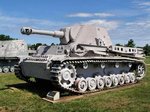The tiger chassis was selected because the German gun was not the same SP-Gun concept the Americans used. Instead of a ridged mounting with mostly elevation , the German gun was extended out the back with hydraulic jack and anchored in position off the rear of the chassis not sure how long this would take. From this point it had a 360° traverse.
Gw Tiger für 17 cm K 72 (Sf)
Geschützwagen Tiger für 17cm Kanone/21 cm Mörser
Grille Series (Cricket Series)
I believe the American gun needed a shovel on the back to be dug in for stability but retained a limited traverse of +/- 14° and elevation of 30° giving a range of 20,000 yards or 19km.
Gw Tiger für 17 cm K 72 (Sf)
Geschützwagen Tiger für 17cm Kanone/21 cm Mörser
Grille Series (Cricket Series)
I believe the American gun needed a shovel on the back to be dug in for stability but retained a limited traverse of +/- 14° and elevation of 30° giving a range of 20,000 yards or 19km.
Last edited:

